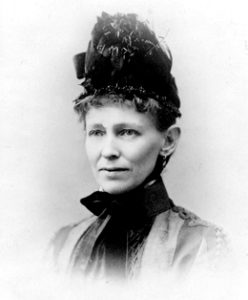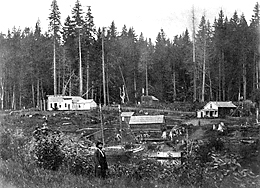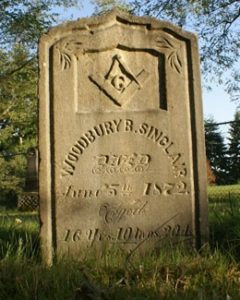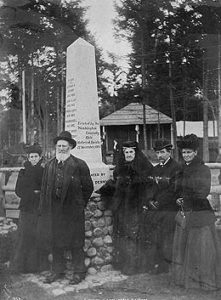
~Forgotten Founder of Snohomish, Washington
By Warner Blake
Walking through the oldest part of our largest cemetery on a sunny afternoon, I easily locate large, even multiple markers with the names Ferguson and Harvey, but none with Sinclair. And amongst the living in our small town the names of Ferguson and Harvey are easily recognized while the mention of Sinclair usually fails to ring a bell.
Emory C. Ferguson and John Harvey settled their claims on opposite sides of the Snohomish River in 1860. East of Ferguson’s claim on the north bank was the Edson Cady claim, which he sold to Mary and Woodbury Sinclair in 1864. Woodbury died suddenly in 1872, just after he and Mary had platted their eastern section of the officially named Snohomish City. Emory and Lucetta Ferguson platted their western section, and John Harvey established a farm and mill on the south bank. The site still has a mill today, but the farm has given way to a busy airport. The Harvey claim is located on the other side of the tracks that marks modern Snohomish’s southern border.
With the death of Mary’s husband, ownership of their claim passed to their two young children, Clarence and Mabel, and the single mother became executor of her children’s estate. Her first act in this later role was to donate three acres alongside the Pilchuck River for a cemetery, which led to the establishment of the Snohomish Cemetery Association, the county’s first public burial ground. Here she buried Woodbury, along with the remains of their infant son Alvin who died shortly after his arrival in this place. Mary purchased a two-foot tall white stone marker, the first in the county.
Secondly, Mary donated “all of block 18” for the first school building in 1874, and within a year a creditable building was on the site, just north of where the Carnegie Library was eventually built. Since the beginning of their residency in Snohomish, classes were held in the Sinclair home and in 1866, Mary’s friend Ruby Willard was paid as the first teacher of School District No. 1, most likely by E. C. Ferguson, the county superintendent of schools. In 1878, Mary married Myron Packard, publisher of The Eye, Snohomish’s second newspaper, but ten years later they were legally separated and Mary petitioned the court to restore her name to Mary Low Sinclair. It was not front-page news.
Sinclair was an early investor in the Athenaeum Society shortly after Woodbury’s death. This was a regionally recognized literary society that published a monthly, handwritten newsletter, established the first library by the pooling the books of members, and built the grand two-story Athenaeum building in 1876. The spirit of the organization later inspired the populist petition of the Carnegie Foundation for funds to build a library that was awarded in 1909. She is credited with starting the local dairy industry with her cow “Rose” a gift from her father; and she donated property for the railroad. In fact, both the arrival of the first train and the filing of her divorce papers took place in 1888 when she was listed as one of the leading taxpayers for Snohomish County.
Because the students coming to Mary’s home were children of Indian mothers, Mary became conversant in the indigenous languages and dialects over the years and was often called upon by journalists and government officials to act as interpreter. The last recorded such event was in 1920, when she helped a reporter from Seattle’s Post-Intelligencer interview Snohomish’s famous Pilchuck Julia. Three years later, “Princess Julia” died from small pox and was the last person buried in the cemetery established with the Sinclair donation fifty years earlier.
- The Low Family Arrival in Puget Sound, 1851
Mary Elizabeth the first of four children of Lydia (Colburn) and John N. Low was born on December 11 1842, in Bloomington, Illinois. Four months into her ninth year, the family left Illinois to migrate west via the Oregon Trail. Just outside of Fort Laramie the Low party passed the Arthur Denny party, who were also from Illinois. Both parties met again at The Dalles, Oregon, and traveled together to Portland. Finding passage aboard the schooner Exact, the expanded Denny party, which now included Mary Ann (Boren) and Arthur Denny’s new baby, plus the William N. Bell family, along with the Low family of six, disembarked on a rainy beach at Alki on November 13, 1851.
While the Denny party moved across the bay to establish the future town site of Seattle, the Low family remained at Alki where John began producing pilings for wharves in San Francisco. Low sold his lumber business and the family moved to Olympia then to Port Madison on Bainbridge Island. Ten years had passed since their arrival at Alki, and nineteen year old Mary was teaching at a school where her future husband, her boss, was the district school clerk.
Woodbury B. Sinclair, born in Penobscot County, Maine July 20, 1825, arrived in Seabeck, Kitsap County, Washington Territory in 1856, as co-founder of a lumber company. In the census of 1860, he was listed as single, age thirty-three, a farmer, had $5,000 invested in real estate and $100 worth of personal estate. He and Mary were married at her father’s home in Kitsap County, March 4, 1862. The couple was described as “Mr. Sinclair, the handsome clerk and Miss Mary Low, the vivacious little teacher.” Two years later Woodbury went on ahead to Snohomish, then called “Cadyville,” in order to establish a logging camp for a local company, and ended up buying out Edson Cady. With William Clendenning he opened a small trading post on the north bank of the Snohomish River that catered to local loggers. “As the steamer landed at the gravel bank near the foot of Maple Street, a small clearing appeared in the otherwise unbroken timber. The town consisted of a rough log house on the bank in which supplies were stored. The store farther back, was a twelve by sixteen foot shack. The old building still standing [1911] at the corner of Maple and Commercial Streets, without windows, doors, or floor, in time was used for the store, with living rooms in the back.” The Sinclair’s infant son Alvin died 20 days later.

On the last day of April 1865, Mary Low Sinclair and her one-month-old son Alvin, boarded the small, unfinished steamer Mary Woodruff in Port Madison for a journey across Puget Sound and up the Snohomish River to the place called Cadyville, arriving the next day, the first day of May. Forty-six years later, Mary remembered that day in an article for the Snohomish County Tribune, published in 1911:
“There was much to do, but the pioneers were hustlers and could turn their hands to anything — no specialists in those days. The women, young and hopeful, fearing neither danger nor privation, soon began to make things look homelike. A large fireplace assisted considerably in clearing the dooryard, in which later bloomed old-fashioned flowers — Sweet Williams, Marigolds and Hollyhocks. There was no time to be lonesome; frogs sang cheerily in the nearby marshes; mosquitoes kept the people busy building smudges. Wild game was plentiful. The Indians brought venison, wild ducks, fish and clams. Also the ranchers from Snoqualmie Prairie brought delicious hams and bacons of their own curing.”
- Sinclair Property
A second son was born on November 14, 1866, whom they named Clarence Wood Sinclair, and he lived to become a popular captain of early Snohomish’s favorite steamship the Nellie in the 1870s.
“For two years there was no regular steamer outside, and the only fruit available was wild berries. But living was cheap and good, and not a butcher shop in forty miles. The Indian wives of the ranchers made sociable calls on their white neighbors, conversing in mingled Boston, Chinook, and Siwash Wa Wa (talk).”

Sinclair 1905 Mabel “May” H. Sinclair was born on April 28, 1869, and lived until 1935. Son Clarence died in 1905 from a sudden illness. And Mary died on a Sunday, June 11, 1922, following three days of illness. She was seventy-nine years old, still living in her home on Pearl Street, and still active as far as we know. The June 16th issue of the local paper carried no mention of her passing. The following week’s issue published a paragraph on the front page that read: “Mrs. Sinclair Was Earliest Settler In Snohomish. E. C. Morse, former Snohomish resident, in a letter to the Tribune concerning the death of Mrs. L. Sinclair, pioneer woman of this city, who died last week, states that Mrs. Sinclair was the first white woman to settle and make a home in Snohomish county, and was also the original owner of the town site Snohomish, eastern part.”
The Everett Herald, on the other hand, published an extensive obituary beginning on the front page, June 12, 1922, which told the story of her childhood and her parents, Lydia and John, who also settled in Snohomish around the time of Woodbury’s passing. The remains of all family members were interred in the town’s first cemetery.
 The Catholic Church founded a second cemetery in 1895; but what was to become the largest cemetery was established in 1898 by the Grand Army of the Republic, a Civil War Veteran’s group, simply referred to as the G.A.R. — both were located outside of town. Over the years, the picturesque cemetery alongside the river, framed by a white picket fence, was no longer needed for the newly dead, and so became neglected and eventually referred to as the “Indian Cemetery.” Consequently, not enough attention was paid in the 1940s when the Washington State Department of Transportation claimed that all of the pioneer graves had been moved to other cemeteries, when it extended 2nd Street north, cutting the historic cemetery site in two. There is no record of the Sinclair or Low remains being moved to the G.A.R. Only Woodbury’s faded white headstone, the imagined centerpiece of the Sinclair memorial, was rescued by the Snohomish Historical Society in the 1980s, and it was reset in a prominent position in the Society’s display of a pioneer graveyard.
The Catholic Church founded a second cemetery in 1895; but what was to become the largest cemetery was established in 1898 by the Grand Army of the Republic, a Civil War Veteran’s group, simply referred to as the G.A.R. — both were located outside of town. Over the years, the picturesque cemetery alongside the river, framed by a white picket fence, was no longer needed for the newly dead, and so became neglected and eventually referred to as the “Indian Cemetery.” Consequently, not enough attention was paid in the 1940s when the Washington State Department of Transportation claimed that all of the pioneer graves had been moved to other cemeteries, when it extended 2nd Street north, cutting the historic cemetery site in two. There is no record of the Sinclair or Low remains being moved to the G.A.R. Only Woodbury’s faded white headstone, the imagined centerpiece of the Sinclair memorial, was rescued by the Snohomish Historical Society in the 1980s, and it was reset in a prominent position in the Society’s display of a pioneer graveyard.
Writing this in 2008, I can report that city funds have been allocated to create a memorial on the eastern side of the divided cemetery site, the part that borders the river, and we hope that both the Sinclair and Low names may be remembered along with the Indian dead who rested in this spot long before the coming of the white people.
Sources:
—Mary L. Sinclair, “Sketch of Early Snohomish Life” (1911) reprinted in The Snohomish Story: From Ox Team to Jet Stream, Official Program, Snohomish Homestead Centennial, July 1959, p. 12;
—Stuart Eskenazi, “The Misplaced Pioneers,” The Seattle Times, September 2, 2001, pp. B1-2;
—“River Reflections: Snohomish City 1859-1910,” Snohomish Historical Society, (undated), pp. 54-55
—“Mary L. Sinclair Called by Death: An Early Pioneer,” The Everett Daily Herald, June 12, 1922, p. 1;
—“Mrs. Sinclair was Earliest Settler in Snohomish,” Snohomish County Tribune, June 23, 1922, p.1;
—Junius Rochester, “Low, John Nathan (1820-1888) and Lydia Low (d. 1901),” HistoryLink.org Essay 1049, November 2, 1998;
—Warner Blake, Early Snohomish (South Carolina: Arcadia Publishing, 2007);
©2008 Warner Blake; WLP Story # 53
